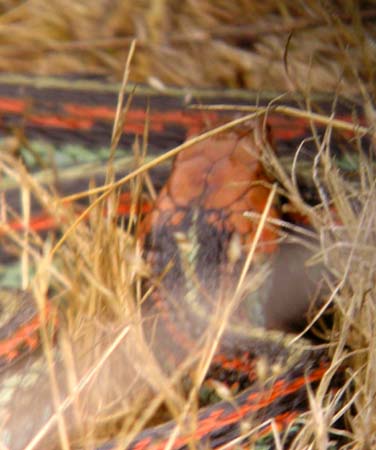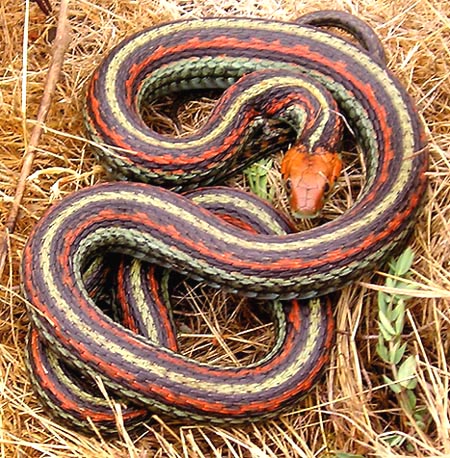
SAN FRANCISCO GARTER SNAKE
Thamnophis sirtalis tetrataenia

|
It is also among California's rarest snakes. It has been official designated as "Endangered" on State lists since 1966, and was on the first Federal Endangered Species List established in 1973. Once common in stock ponds and small marshes in San Mateo County on the San Francisco Peninsula, it has been reduced to a mere handful due to urbanization, the draining and pollution of wetlands, and because its beauty makes it popular with illegal collectors. A recent population estimate was of ~1500 snakes. It has been completeley extirpated from many areas it was once common (e.g., Skyline Road area along the ridge between the Pacific Ocean and S.F. Bay or around Sharp Park golf course in Pacifica) and the remnant populations are now limited to a few wetlands near S.F. Airport; around Crystal Springs Reservoir; and locally along the San Mateo County coast from Pacifica to Pt. Año Nuevo. It has been recorded to Waddell Creek, one mile into northern Santa Cruz County, but for all practical purposes the sustainable populations are endemic to San Mateo County. |
 |
all photos
are of wild and unrestrained snakes in native habitats |
  This
garter snake is primarily a frog-eater, and thus it sticks close to
water.
Much of its remaining habitat is in small reedy marsh-edges and ponds.
Note the many colors among the reeds (near right): green, rust, pale
tan.
Among this kaleidoscope the smallish snake (1 to 3 feet typically;
maximum
4.25 feet) is amazingly well camouflaged. While the color pattern can
be
discerned among the grass at close range (far right; the snake is
facing
away), at any distance it just blends into the habitat. On the day
these
photos were taken, Dan Singer and John Sullivan and I saw five S.F.
Garter
Snakes, but three of them slithered into the pond before we could take
photos: they had spotted us before we had seen them! Eaton (2002)
thought
the bright patterns might be a warning to predators, but I think just
the
opposite: the crisply patterned colors fit the snake's preferred
habitat
and hide it from predators. Only when the ponds dry up in late summer
does
it move into uplands, spending the winter in small mammal burrows. This
garter snake is primarily a frog-eater, and thus it sticks close to
water.
Much of its remaining habitat is in small reedy marsh-edges and ponds.
Note the many colors among the reeds (near right): green, rust, pale
tan.
Among this kaleidoscope the smallish snake (1 to 3 feet typically;
maximum
4.25 feet) is amazingly well camouflaged. While the color pattern can
be
discerned among the grass at close range (far right; the snake is
facing
away), at any distance it just blends into the habitat. On the day
these
photos were taken, Dan Singer and John Sullivan and I saw five S.F.
Garter
Snakes, but three of them slithered into the pond before we could take
photos: they had spotted us before we had seen them! Eaton (2002)
thought
the bright patterns might be a warning to predators, but I think just
the
opposite: the crisply patterned colors fit the snake's preferred
habitat
and hide it from predators. Only when the ponds dry up in late summer
does
it move into uplands, spending the winter in small mammal burrows. |
|
San Francisco Garter Snake is, as we have seen, an endemic snake to San Mateo County and does not occur in San Francisco [except at the California Academy of Science's herpetarium where some of these rare snakes were stolen in a burglary a couple of years back]. It is also a subspecies [tetrataenia] of what is known as the Common Garter Snake Thamnophis sirtalis: a species found across the United States and into southern Canada. There are 13 recognized subspecies based on color pattern variation (Rossman et al. 1996), seven of which occur in the western U.S. (Stebbins 1966, 1985, 2003). Obviously, the San Mateo County subspecies tetrataenia is anything but "Common"! One of the rarest snakes in the world is a race of "Common Garter Snake." As it happens, Common Garter Snake is decidedly unusual in several aspects. Not only is one of the subspecies exceedingly rare, but some western populations have evolved the ability to eat California Newts Taricha torosa, a salamander that exudes a poison on its skin that is toxic to most other snakes (see Brodie & Brodie 1999). The San Francisco Garter Snake will eat newts when encountered, but its principal food prey is small frogs, and particularly California Treefrog Hyla regilla and young Red-legged Frog Rana aurora. The latter is an Endangered Species (the California race draytoni is listed as Threatened on the Federal Endangered Species list) in its own right — so we have the unique situation of one Endangered Species eating another Endangered Species for its livelihood! Name confusion is not limited to English common names; recent controversy has swirled around the scientific name of this beast. Boundy & Rossman (1995) pointed out some nomenclatural problems among Pacific coast populations and suggested that the San Francisco Garter Snake, previously known as T. s. tetrataenia, become T. s. infernalis, and that those populations known as Red-sided Garter Snake T. s. infernalis be included with T. s. concinnus[Red-spotted Garter Snake]. This proposed change was followed by Rossman et al. (1996) in their book about garter snakes. However, the change was bound to cause nothing but confusion. Barry et al. (1996) petitioned the International Commission on Zoological Nomenclature (ICZN) to suppress the changes proposed by Boundy & Rossman. In 2000, the ICZN agreed and voted to retain the historical taxonomic arrangement of subspecies within this evolutionary lineage. Accordingly, the subspecies tetrataenia was reinstated for San Francisco Garter Snake and the races concinnus and infernalis retain their historical definition (e.g., see Stebbins 1996, 2003). |
| It is also interesting to consider the evolution and taxonomy
of San Francisco Garter Snake (below left). Let's compare it to
its geographically nearest subspecies: California Red-sided Garter
Snake
T.
s. infernalis (below right). The photo of infernalis was
taken
in Aptos, Santa Cruz County, just 15 miles from the range of tetrataenia.
Indeed, the gap in their range appears to be just a stretch of 12 miles
of coast in northern Santa Cruz County between the northernmost Santa
Cruz
infernalis
and the tetrataenia population at Año Nuevo [based on
on-line
data of over 300 specimens at Cal. Academy and Museum of Vertebrate
Zoology,
Berkeley]. Yet I am not aware of any integrades between them.
As you can see in the photos below, San Francisco Garter Snake differs from California Red-sided Garter Snake by:
|
 |
 |
| Although the above comparison suggests that San Francisco
Garter Snake
is a quite unique taxon, molecular studies are less certain. Janzen et
al. (2002) analyzed sequences in mitochondrial DNA to determine
relationships
within Common Garter Snake T. sirtalis. They found that
molecular
evidence differed, sometimes sharply, with the boundaries of subspecies
named on phenotypic variation. They suggest that local environmental
forces
were more important in shaping the color patterns shown by the garter
snakes
than were shared common ancestry, and they considered all
morphologically
based subspecies in the western U.S. to be invalid (but they declined
to
name new subspecies).
Focusing on the situation around the San Francisco Bay Area, they found that a group of three populations that circle the Bay Area (Sonoma Co., Contra Costa Co., and Santa Clara Co. [=Gilroy; apparently mistakenly attributed to Santa Cruz Co. in their text]) formed a divergent group ("the California clade") that was diagnosable and had an "elevated rate of molecular evolution." These are populations of Red-sided Garter Snake currently listed as T. s. infernalis. Janzen et al. (2002) stated that it was "also remarkable that the populations in this group are only ~25-125 km away from [tetrataenia] in San Mateo Co., yet genetic distinctness from this nearby population is readily apparent." Despite the "genetic distinctness" of S. t. tetrataenia from the adjacent Common Garter Snakes, Janzen and colleagues concluded that "T. s. tetrataenia is not genetically unique from other California populations." This was because the lone sample of tetrataenia grouped with snakes from El Dorado and/or Santa Barbara counties in the phylogenetic tree created from their data. This seems to me to be an odd conclusion. It has been quite some time since there was any genetic exchange between San Francisco Garter Snake and those in the Sierra Nevada or Santa Barbara. The intervening snakes (California Red-sided T. s. infernalis) have undergone genetic change. If those in San Mateo County have not, this lack of genetic change means that either (a) S.F. Garter is a ancient remnant population now separated from its relatives or (b) something else is going on genetically. The S.F. Garter Snake may well be "unique" -- especially considering just how different they look — but perhaps we don't yet have the evidence. I suspect that mitochondrial DNA may have been an imprecise tool for the question under consideration: is T. s. tetrataenia a distinct and separate taxonomic unit? Janzen et al. (2002) explicitly leave this question open. I wonder if newer techniques [e.g., sequencing nuclear DNA; see Barker et al. (2002) with respect to birds: nuclear DNA sometimes gave better estimates of relationships than mitochondrial DNA] might shed further light on this topic. |
|
A final point of interest to me was learning how San Francisco Garter Snake managed to survive in habitats that host two other species of garter snake: Coast Garter Snake Thamnophis elegans terrestris [a subspecies of Western Terrestrial Garter Snake T. elegans] and Santa Cruz Aquatic Garter Snake Thamnophis atratus atratus [a subspecies of Aquatic Garter Snake T. atratus]. A quick glance through Stebbins (2003) or Rossman et al. (1996) shows that they all are listed as eating the same foods. But the sequence in which the prey is listed differs, and John Sullivan is quite right to quote herpetologist Sean Barry who said that where these species overlap, they divide up the habitat this way:
|
On-line resources
Fine photos of all these garter snakes appear on the following web
sites :
Barker, F.K., G.F. Barrowclough, and J.G. Groth. 2002. A phylogenetic hypothesis for passerine birds: taxonomic and biogeographic implications of an analysis of nuclear DNA sequence data. Proc. Roy. Soc. Lond. B. 269: 295-305.PHOTOS: All photos © 2004 Don Roberson, all rights reserved.Barry, S. J., M. R. Jennings, and H. M. Smith. 1996. Current subspecific names for western Thamnophis sirtalis. Herpetological Review 27: 172-173.
Boundy, J., and D. A. Rossman. 1995. Allocation and status of the garter snake names Coluber infernalis Blainville, Eutaenia sirtalis tetrataenia Cope, and Eutaenia imperilais Coues and Yarrow. Copeia 1995: 236-240.
Brodie, E.D., III, and E.D. Brodie, Jr. 1999. Costs of exploiting poisonous prey: evolutionary trade-offs in a predator-prey arms race. Evolution 53: 626-631.
Eaton, J. 2002. San Francisco's Patron Snake. Faultlines on-line environmental magazine, Sept. 12, 2002.
International Commission on Zoological Nomenclature. 2000. Opinion 1961. Bulletin of Zoological Nomenclature 57: 191-192.
Janzen, F.J., J.G. Krenz, T.S. Haselkorn, E.D. Brodie, Jr., and E.D. Brodie, III. 2002. Molecular phylogeography of common garter snakes (Thamnophis sirtalis) in western North America: implications for regional historical forces. Molecular Ecology 11: 1739-1751.
Rossman, D.A., N.B. Ford, and R.A. Seigal. 1996. The Garter Snakes: Evolution and Ecology. Univ. Oklahoma Press, Norman, OK.
Stebbins, R. C. 1966. A Field Guide to Western Reptiles and Amphibians. Houghton Mifflin, Boston.
Stebbins, R. C. 1985. A Field Guide to Western Reptiles and Amphibians. 2d ed. Houghton Mifflin, Boston.
Stebbins, R. C. 2003. A Field Guide to Western Reptiles and Amphibians. 3d ed. Houghton Mifflin, Boston.